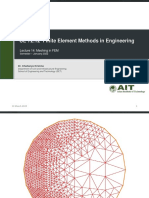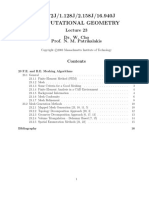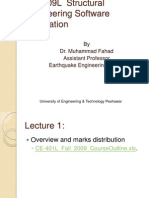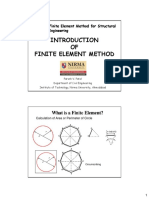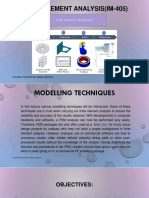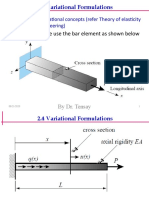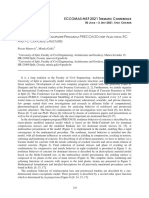0 ratings 0% found this document useful (0 votes) 34 views 6 pages 1994 Benchmark
This paper presents an approach to FEM pre- and post- processing by means of the widely used CAD program AutoCAD. An object oriented paradigm in defing structure geometry enables a high level of data abstraction in the pre-processing phase. Mesh generation, as well as generation of boundary conditions and loads which are defined over the geometrical entities, are performed using the, so called, block mapping technique. A finite element mesh created in this way is well-conditioned and allows the
Copyright
© © All Rights Reserved
We take content rights seriously. If you suspect this is your content,
claim it here .
Available Formats
Download as PDF or read online on Scribd
Go to previous items Go to next items
Save 1994 Benchmark For Later BENCH, Yj,
Modelling
for Efficient FE Meshing
thin the CAD Environment
Pavao Marovic, Associated Professor, Goran Gusic, Researcher.
Faculty of Civit Engineering,
University of Split, HR-58000 SPLIT,
Matice hrvatske
15, CROATIA, tel. (385) (058) 551-
475, fax. (385) (058) 524-162;
SUMMARY
This paper presents an approach to
FEM (Finite Element Method) pre-
and post- processing by means of the
widely used CAD (Computer Aided
Drawing) program AutoCAD. An
object oriented paradigm in defining
structure geometry enables a high
level of data abstraction in the pre~
processing phase. Mesh generation, as
well as generation of boundary
conditions and loads which are
defined over the goometrical entities,
are performed using the, so-called,
block mapping technique. A finite
‘element mesh created in this way is
‘well-conditioned and allows the use of
different finite element types which is
‘one of the best features of mapping
techniques. The wide open
architecture of AutoCAD also enables
fast definition of the input data,
‘The work presented has produced two
programs, one inside AutoCAD which
converts a geometry model into its
‘mumerical correspondent and the
other one which generates the finite
clement mesh outside the AutoCAD
based on the preduced numerical
model. Both programs —_ are
incorporated in the FEME (Finite
Element Modelling Extension)
programme package, whose
performance is illustrated by a few
examples.
1. INTRODUCTION
In recent years large physical
problems have been solved by means
of numerical methods. Huge amounts
of data, concerned with these
problems and their appropriate
handling have arisen as objective
FAST-INFO/ @®
difficulties. The need for the visual-
isation of solutions and simpler data
input became a necessity. These
facts give rise to two new phases in
numerical modelling by computer
pre-processing (definition of input
datay and post-processing
(visualisation of obtained results)
uh
‘The Finite Element Method (FEM),
is the most common method in the
area of structure numerical
simulation, appeared during the
1950's, wien the solutions of
numerical simulations appeared as
vast listings of the numerical data,
presenting stresses and
displacemeats in the discrete points
of the model. The process of
converting areal structure
‘model into numerical data has also
resulted in data increase. This
phenomenon resulted in many errors
in the data input phase. More and
more complicated geometry and
increasing demands for complex
structure description made it
impossible to properly use te resalts
produced by the FE model. Thus, the
problem of data visualisation arose
in the domain, first in the data input
and later in the data output. For this
purpose many graphical packages
have been used. However, today the
most widely used package is
AutoCAD 2]
According to the presented facts,
this article briefly describes the
FEME (Finite Element Modelling
Extension) programme package (3,
4]. FEME is at the same time a pre-
processor and post-processor for any
finite element program and is based
on the CAD program package
AuloCAD. It has a built-in mesh
‘generator for pre-processing
2, MESH GENERATION
TECHNIQUES
The adoption of the geometry based
definition of the problem and
automatic production of a valid finite
clement discretisation without user
intervention is the major property of
the mesh generators which represents
apart of the reliable application ofthe
finite element techaique. This results
in the reduction of input data, mainly
topology data of finite elements, and
their co-ordinates. This also reduces
the possiblity of producing errors.
Most of the research in the area of
mesh generation is focused on
techniques such as 2D-quadtree [5].
3D-vctree [6], trizngulation, paving
(7) or on the -different mapping
techniques. The mapping technique is
used in this paper as well as in papers
1B, 4]. The main advantages of
mapping techniques (block decomp-
sition, transfinite mapping) are
Boundary Sensitivity: mesh contours
follow the contours of the boundary;
Orientation Insensitivity: rotation or
‘translation of the given domain does
not change the mesh topology;
Element Versatility’ these techniques
ccan be developed for different finite
‘element types.
Geometrically based finite clement
‘mesh generators (5, 6, 8, 9] are, in
comparison to the block mapping
technique, at a higher level of
automation, Despite this property
these techniques are usually used for
only one finite clement type
‘The quadtree mesh generator [5] is
based on a spatial decomposition
procedure of the 2D' domain into a set
of disjointed squares. These squares
are referred to as quadrants that are
stored in a hierarchic tree. The root of
the tree is given as a square that
encloses the observed domain, Within
the discretisation defined by the
quadtree, the mesh topology is defined
on a quadrant-by-quadrant basis,
using the information stored in the
March 1994 Page 23
*�quadtree. The cctree technique [6] is
very similar but only for 3D domains
disjointing domain in octaedars.
‘The paving technique (7] is based on
iteratively layering rows of elements
‘within the interior of a domain's
‘boundaries. As rows begin to overlap
or coincide in the interior of the
scometry, they are carefully connected
together to produce valid topology of
the finite element mesh.
3.0 BLOCK MAPPING
TECHNIQUE
3.1 INTRODUCTION
‘The block mapping technique was
introduced in 2D planar domains in
1971 {10}. The domain, according to
this technique, is subdivided into
blocks which are compatible in the
same way in which the fiite elements
are; then, follewing the subdivision
parameters for each block, the blocks
are mapped and subdivided into a
valid finite element mesh,
The tedious geometry of the finite
clement model can be the source of
errors and of the generation of non-
valid. finite element meshes. This
problem can be avoided by the use of
the geometry based definition of the
blocks by means of CAD modellers.
In this way, errors are minimised even
for manifold objects of arbitrary
‘geometric complexity.
‘The object oriented approach (OOP),
hich has beea used quite often in
programming, transfers the geometry
definition of the domain into its
x
‘mumerical representation in this
nay.
Geometrical entities, such as points,
lines, ares, bezier curves are carriers
of the properties of the finite
‘element model. For cach of these
entities different properties can be
assigned like kinematic boundary
conditions, dynamic boundary
conditions (loads), thickness, etc
Four of these entities, each of them
defining a block edge, have to be
selected 0 create a block which is
then mapped and subdivided to
produce a finite element mesh.
Data hiding, which is one of the
‘common OOP properties, :s used
here to enable invisible correction
between the mathematical medel
and geometrical model, Although
the mathematical model has no
significance for the user it is hidden
behind its geometrical representative
im both pre-processing and post-
processing phase.
The user performs block
discretisation by a CAD modeller
without taking into account its
topology and nodal co-ordinates
which makes FEME a completely
seometically based pre-processor
3.2 MATHEMATICAL
MODEL
‘The mesh generation process starts
afer the definition of the boundaries
of each block and subdivision
Parameters.
Figure 1. Element in global and natural coordinate system with the point inside
the element damain,
Page 24 March 1994
BENCH af
Each block is described by the
‘geometric entities which are carriers
of the Bock boundaries.
Mathematically, the blocks are given
as,
xX=ENx
} @
‘are nodal co-ordinates of 16 node
isoparametric element, and
x= {3}
y
are co-ordinates of each point within
the clement domain, Ni are Lagrange
shape functions. A graphical
representation ofthis process for an 8-
node element, is shown in Figure 1
4
x=t(6n)
y=een)
Once the block is mapped into a
curvilinear co-ordinate system, the
subdivision is performed in the
following way
bet aw
i
Sle laren a7 ae)
m
where ky qiy are parameters of a
geometric series which enable non-
uniform subdivision of the block
domain, ic. the weighting factors
which are used for weight sub-
division
Afier finding the curvilinear co-
ordinates for each node of the finite
clement mesh, co-ordinate mapping
can easily be performed using eq,
.
‘The aforementioned is performed
using the MESHGEN programme
which is incited in the FEME
programme package. Accordingly, the
MESHGEN programme performs
finite clement mesh generation,
evaluates co-ondinates of all nodes,
performs all necessary numberings,
and involves boundary conditions and�Fig. 2 Geometrical model
b— : (
1 2 3
a=——~zk
Fig. 3 Superelements model.
Fig. 4. Generated finite element mesh
‘material properties for all elements,
In the first phase, superelement
topology generation is performed with
the help of subroutine BUILDTOP. In
the second phase, in subroutine
PROPAGATE, the subdivision of
superelement on a given number of
elements m x m is performed, for
chosen parameters m and n, while
simultaneously checking the connect-
ion compatibility between the super-
elements. After the transformation of
the geometrical mode! of the domain
into a correspondent mathematical
‘model, in subroutine MESH, the
generation of finite element mesh is
performed maintaining the boundary
‘conditions and material properties. In
‘the fourth phase, in subroutine
REMDOUBLES, the double nodes are
climinated at superelement contacts.
Overall results of the MESHGEN
programme are oblained in the
databases with exiensions: *,CIF -
database for communication with
Programme AutoCAD; *ELM -
database with all numerical data
(standard alphanumerical input
database) which can be modified in
accordance with the needs of the used
finite clement solver; and *.OUT -
control database. Details of these
procedures can be found in [3].
4. CAD SOFTWARE AND
ITS APPLICATION
In the 1960-5, together with hardware
development, a new group of
‘computer applications was born, CAD
= Computer Aided Design. ‘These
Programs became the tools for
‘geometry modelling both in 2D and
3D spaces.
FEM was adopted in the 1950-s,
‘These ten years and the fact that
design was separated from numerical
simulation of the structure behaviour,
has set apart FEM from CAD. Indeed,
the analysis is not integrated in the
design for good reasons, since, the
design analysis is usually performed
in different departments with different
tools; thus, the gap detween geometry
modelling and structure analysis is
March 1994 Page 25�‘wider than necessary [1]
Model building must be based on a
geometric model. Thus, it is time
consuming 19 build a model
consisting of nodes and elements,
node by node and element by element
‘The CAD modeller can use geometric
operations in both 2D and 3D spaces,
such as union, subtraction and
intersection.
{A variety of functions, incorporated in
the CAD modeller, also enables the
development of the hierarchy of
geometrical entities which define
arbitrary structure geometry.
Functions which have to be developed
for a particular CAD software to
connect CAD with FEM can be
grouped, as follows: transfer;
geometry model, built up by the CAD
modeller can be directly used
selecting the entities which define the
‘model, thus filtering necessary
information about model geometry
without picking up the rest ofthe data
defined in the designing phase
(dimensions, hatch, text, etc.), which
are needed for a proper representation
of the geometry model, trans-
formation; gecmetry completed in this
way, together with parameters for
‘mesh density and relevant data for
FEM model such as material
properties over the region is
transformed info a valid numerical
representation of the geometrical
model. Associating the loads and the
boundary conditions with geometrical
entities, the checking and connection
of the geometry model are performed
in this phase, completion, formatting
the data for use by FEM solvers. The
first two phases are performed in
AuloCAD [2], one of the most
popular CAD software for PC
compatible machines.
FEME, which stands for Finite
Element Modelling Extension, was
developed for this purpose using
AuloCAD's open architecture.
Opening, the architecture of this CAD
tool is performed by the included
‘AuloLISP interpreter [11, 12], which
‘enables the extensive use of all built-
in CAD functions and the
‘manipulation of the graphical objects
Page 26 March 1994
BENCH, 44),
cexisting in the current drawings data
base.
AutoLISP is the part of Common
LISP, a programming language
developed in the 19508 by
McCarthy for the sake of artificial
intelligence rescarch which today
represents one of the oldest
programming languages. Its
flexibility and the fact thet it was
‘wide open for user intervention have
made possible its continual
application.
Graphical objects and lists of
‘graphical objects through AutoLISP
Geometrical model
by using encapsulation, data hiding
and filtering are easily accessed and
manipulated.
AutoLISP, as the first AutoCAD
interface language, is. suitable for
engineering applications because: (a)
itis the chosen language for research
and development of artificial
intelligence and expert systems; (b) it
has an exceedingly simple syntax; (€)
itis ideally suited for the unstructured
interaction that characterises the
design process; and (@) it excels at
collecting the heterogeneous objects
in various sized groups which is
precisely the type of information CAD
‘Supereloment
Finite clement mesh
Fig. 5 Straight-curves cantilever: geometrical model, superelement
‘model and finite element mesh - undeformed and deformed.
Fig. 6 The speed of the programme MESHGEN for different numbers
of nodes and elements for 2 superelements.�systems manipulate.
‘Two special AutoLISP data types are implemented to
provide access to AutoCAD graphical entities: (a) entity
name; (b) selection set. According to the OO paradigm
these data types are manipulated only by functions that act
upon them and their internal structure is irrelevant to the
programmer. An entity name is actually a painter to the
entity's database record and its vectors. A selection set is
simply a collection of entity names,
5. EXAMPLES
‘What is the practical application of the aforementioned?
On the basis of a known geometrical model, its contour
lines are drawn withthe help of the AutoCAD programme.
‘The obtained sketch is then divided in accordance with
material and geometrical properties on blocks -
superelements. Sub element division parameters are then
introduced for each siperelement. The obtained finite
‘elements take over all the properties of the superelement.
So, the generated finite element mesh is obtaised visually
‘on screen in AutoCAD and alphanumerically in database
“ELM, This database can be further used by an appropriate
finite element solver which is connected with the FEME
programme package.
After performing the numerical calculation the obtained
results - displacement and deformation data - can be
relumed into the AutoCAD programme in order to be
visualised.
‘The use of the FEME programme package as a pre-
processor and also as a post-processor is illustrated by two
examples,
EXAMPLE No. 1
The first example chosen to illustrate the possibilities of the
FEME programme package is a dam structure with
surrounding soil. Figure 2 stows the geometrical model of
the structure according to which the superelemeat model,
shown in Figure 3, is evaluated. The result of the
generation of finite element mesh is shown in Figure 4. The
‘obtained mesh is discretised with 175 elements and 598
nodes.
The finite element mesh generated for this example
{together with all data (node co-ordinates, clement topology,
all numerical data concerning nodes and elements, material
properties, etc.) is obtained in about 6 seconds.
EXAMPLE No. 2
‘The second example which is used to illustrate both pre-
and post-processor possibilities of the FEME programme
package is a straight-curved cantilever. Its geometry is
shown in Figure 5 together with the superclement model
and the obtained generated finite clement mesh, The
deformed mesh obtained by one finite element solver for the
linear stress and strain analysis [13] is evaluated in the
same figure,�6. CONCLUSIONS
‘This article presents the possibilities
of the FEME (Finite Element
Modelling Exiension) programme
package, evaluated for pre- and post-
processing of input and output data
for any finite element solver by means
‘of CAD programme AuloCAD. It is
worth mentioning thatthe preparation
of input data by drawing instead of
typing all alphanumerical data is
such quicker and more precise.
‘The evaluated FEME programme
package was tested on several
examples considering the speed
performances. Some results
concerning speed of the meshing
procedure obtained © for two
superclements, by varying the number
of nodes and elements are shown in
Figure 6. That figure and practical
experience show what improvements
in working speed, cost reduction and
accuracy can be obtained using the
FEME programme package.
‘The FEME programme package is
being tested now. It should be
improved by fulfilling all the
requirements roquested by appropriate
NAFEMS benchmark tests [14] before
ican be professionally used.
7. REFERENCES
U1] G, Butlin, State-oFthe-art Pre-
‘and Post-processing, FAM technical
paper, FEGS Ltd., England, UK.,
Doc. TP-87.10, 1987.
[2] N. Johrson, AutoCAD: The
Complete Reference, Second Edition,
Osborne McGraw-Hill, New York,
1991
[3] G. Gusi), Preparation of input
data and visualization of output data
for finite clement solver using
AuloCAD, Diploma Thesis, Faculty
of Civil Engineering, University of
Split, Split, 1993. (in Croatian)
[4] P. Marovi} and G. Gusi3,
Interfacing FEM with AutoCAD,
Proc. 2nd Conf SCSE Civil
Engineers in Rebuilding
Croatia, Brijuni, Ed. J, Radi}, pp.
149-154, 1993. (in Croatian)
Page 28 March 1994
BENCH ak
[5] PL. Bachmann et al,, Robust
Geometrically Based Automatic
‘Two-Dimensional Mesh Genzration,
Int. J. for Num, Meth. in Engng.,
Vol. 24, pp. 1043-1078, 1991.
16] MS. Shepard and MK.
Georges, Automatic Thee
Dimensional Mesh Generator by the
Finite Octree Technique, Int. J. for
‘Num, Meth, in Engng,, Vol. 32, pp.
709-749, 1991.
[7] TD. Blacker and MB.
Stephenson, Paving: A New
Approa: to Automated
‘Quadrilateral Mesh Generation, Int
J. for Num. Meth. in Engng., Vol.
32, pp. 811-847, 1991
[8] J.C. Cavendish, D.A. Field and
WH. Frey, An Approach to
Automatic Three-Dimensional Mesh
Generation, Int. J. for Num. Meth,
in Engng, Vol. 21, pp. 32
1985,
[9] V.N. Kaliakin, A Simple
Coordinate Determination Scheme
For Two Dimensional Mesh
Generation, Computers &
Structures, Vol. 43, No. 3, pp. 505-
516, 1993,
[0] O.C. Zienkiewiez and D.V.
Phillips, An Automatic Mesh
Generation Scheme for Plane and
‘Curved Surfaces by Isoparametric
‘Coordinates, Int. J for Nun. Meth.
Engng, Vol. 3, pp. 519-528, 1971
[11] AutoLISP, Release 11,
‘Programmer's Reference,
AUTODESK, 1992,
[2] V. Liubi~, 1. Turk and T.
Knific, AuloCAD and AutoLISP,
FAGG & IKPIR, Ljubljana, 1991
(in Slovenian)
[13], Hinton and D.RJ. Owen,
Finite Element Programming,
Academic Press, London, 1977.
[14] B. Spooner, Benchmarks for
Finite Element’ Pre-processors,
NAFEMS Poblication Benchmark,
October 1990.




